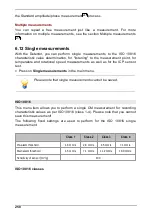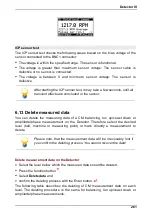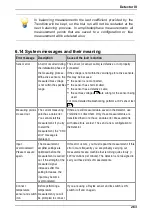
272
Bear in mind that a time signal may NOT have b een recorded
when an alarm was output for a characteristic value even if the field
"Save in the event of main alarm" was activated. Time signals that
should b e saved in the event of an alarm can only b e saved if
sufficient memory is availab le.
The recorded time signals are always acceleration signals, which are each
filtered and sampled differently. The Detector can measure three different time
signals. Here you can choose from three different measuring branches
.
For the calculation of the characteristic velocity values ISO10816 and V
sel
the
transformation from the acceleration signal into the velocity signal is done in the
frequency domain. Therefore, for these characteristic values the acceleration
signal is always stored and displayed for the time signal. The time signal
sampling rates are set for each channel by the lowpass settings.
7.4 Dynamic memory management
The Detector offers dynamic memory management. Because of this, the
partitioning of the memory is not defined in the firmware. For measuring points,
time signals, etc. there is a memory block of 2.7 MB. You can set in the Trendline
software whether many configurations or many time signals are needed when
taking the next measurements. The required memory can be calculated as
follows:
Memory element
Memory usage
Configuration
CM configuration: 572 by tes
Balancing configuration: 394 by tes
Run up/coast dow n: 272 by tes
Amplitude/phase configuration: 290 by tes
Free measurement
CM measurement: 588 by tes
Balancing measurement: 408 by tes
Run up/coast dow n: 286 by tes
Amplitude/phase measurement: 304 by tes
Templates
CM configuration: 588 by tes
Balancing configuration: 410 by tes
Run up/coast dow n: 288 by tes
Amplitude/phase configuration: 306 by tes
Time signal
8244 by tes (1600 lines), 16436 by tes (3200 lines)
Balancing step
244 by tes
Run up/coast dow n
94 by tes + (n * 12) by tes per Amplitude/phase v alue
(n = number of reference points)
273
















































